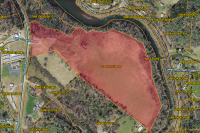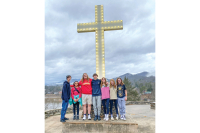Orthopedist shortage costs HRMC patients, revenue
Every morning, the dispatcher for Haywood Emergency Medical Services starts his shift with a call to the emergency room of Haywood Regional Medical Center.
“Is there an orthopedist on call today?” the dispatcher asks.
Half the time, the answer is “no.” The dispatcher relays this news over the scanner to all EMS and Rescue Squad drivers. For the next 24 hours, any patients with broken bones or joint injuries will be driven straight past Haywood Regional to Mission Hospital in Asheville.
The lack of orthopedists in Haywood County — there are only two — has contributed to a slump in patient volume in recent months, according to hospital officials. The slump in patients meant less money coming in, resulting in a negative operating margin for three months, which in turn prompted a workforce reduction of 36 employees at the hospital two weeks ago. The workforce reduction is expected to save around $1.5 million annually.
The hospital can lose up to half a dozen patients a day when there is no orthopedist on-call. One broken hip can mean weeks in the hospital — racking up X-rays, blood work and perhaps surgery — followed by months of rehab. That one lost hip patient amounts to tens of thousands in revenue.
“Some days when there’s no orthopedic on-call coverage, we might not transport anyone to Mission. Some days we might transport five or eight. It really depends,” said Marty Stamey, the Emergency Services director.
Related Items
Both hospital CEO David Rice and Vice President Eileen Lipham said the lack of on-call orthopedists has been a “contributing factor” in the hospital’s negative operating margin, leading to the layoffs.
Haywood Regional hasn’t always been in this quandary. The orthopedics practice in Haywood County collapsed nearly three years ago after orthopedic doctors got in a dispute with the hospital over the way they were being treated. In hindsight, the incident was a harbinger of more fallouts between hospital administration and the medical community to come. There was a mass exodus of anesthesiologists; the ousting of the emergency room doctors; a general feeling among physicians of being disenfranchised from the hospital decision-making process; and most recently a parade of resignations by long-time nurses.
Meanwhile, recruiting new doctors hasn’t gone so well. It’s been nearly three years and the hospital has only been able to recruit the two orthopedists, leading to no on-call orthopedists 50 percent of the time.
The failure to recruit orthopedists can’t be chalked up solely to the county’s rural nature. Harris Regional Hospital in neighboring Jackson County has a team of six orthopedists under the group Sylva Orthopedic Associates. Jackson has a population of about 35,000 to Haywood County’s 56,000, but has three times more orthopedists.
Meanwhile, a private orthopedics practice has set up shop in Haywood County in competition with the hospital. Southeastern Sports Medicine has a Haywood County office but sends patients to Mission Hospital in Asheville. Despite the practice’s name, it takes all kinds of broken bones and joint problems, not just sports-related injuries.
The orthopedist at the Haywood office of Southeastern Sports Medicine, Dr. Richard Jones, used to be affiliated with Haywood Regional, but he left as part of the orthopedist collapse three years ago. Jones claimed he was being worked too hard. As one of only two orthopedists at the time, he was required to be on call every other night, disrupting his day-time practice. The hospital since changed the policy: the two orthopedists they have now have to be on-call only once every four nights. The hospital and Jones are still in a lawsuit over Jones’ departure.
The hospital had a new orthopedist lined up this summer, but he backed out. The hospital now thinks it has two new orthopedists lined up to come here in the not-too-distant future.
“Based on the progress we have made in our recent recruitment efforts, we are encouraged that a resolve may be in the making by the end of this year,” Rice said.
The lack of orthopedists — and the resulting out-migration of patients — doesn’t alone account for the downturn in patients . The orthopedist crisis has been ongoing for more than two years, while the downturn in patients has been noted only in recent months.
Rice also cited a “trend of wellness” in the community as a factor. In other words, not as many people being sick. But Harris in Sylva has seen a 14 percent increase in patients this year, and Mission has seen a 3 percent increase.
Financial statements show that revenue coming into the hospital did not decline, so much as expenses went up. Expenses for the past 10 months are up by nearly $3 million over last year’s expenses.
Typically, the hospital’s operating margin hovers around 5 percent based on statistics since 2002. It sees a monthly positive cash flow of between $300,000 and $400,000. The year-end profit margin has been roughly $3 million on average, based on statistics since 2002. The positive financial figures are one reason hospital officials felt comfortable self-financing a planned $16.5 million hospital expansion that includes a surgery center, lobby and administrative offices.
But three months ago, the finances took a downward turn. The monthly operating margin was in the red by $120,000 in April and $315,000 in June. In May the operating margin was $88,000. June was clearly the most alarming — the operating margin was $700,000 off from where an average month should be (July figures are not yet available).
While the hospital still has a positive operating margin for the year, the three months of losses brought the margin down by about $1 million from where it should be compared to previous years. Another three months of similar performance could create cash flow problems.









